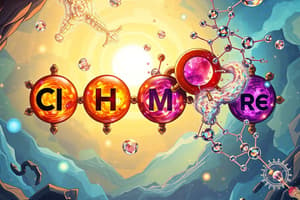Podcast
Questions and Answers
What is one potential application of covalent organic frameworks (COFs)?
What is one potential application of covalent organic frameworks (COFs)?
- Catalysis (correct)
- Data storage
- Food packaging
- Clothing production
How has computational modeling contributed to inorganic chemistry?
How has computational modeling contributed to inorganic chemistry?
- By reducing the need for laboratory experiments
- By enabling the study of transition states of chemical reactions (correct)
- By creating new types of catalysts
- By increasing the toxicity of certain chemicals
What is an example of an application of electron-rich metals?
What is an example of an application of electron-rich metals?
- Biodegradable packaging materials
- Nonflammable gel polymer electrolytes for lithium-ion batteries (correct)
- Faster cooking pots
- Synthetic textiles with enhanced color retention
What has materials science developed a fast, low-cost, scalable method for producing?
What has materials science developed a fast, low-cost, scalable method for producing?
What field has inorganic chemistry contributed to through the study of heavy elements and superheavy elements?
What field has inorganic chemistry contributed to through the study of heavy elements and superheavy elements?
What is the potential impact of a novel catalyst system for CO2 conversion?
What is the potential impact of a novel catalyst system for CO2 conversion?
Which technique has been used to quickly calculate the transition state structure of a chemical reaction?
Which technique has been used to quickly calculate the transition state structure of a chemical reaction?
What are covalent organic frameworks (COFs) known for?
What are covalent organic frameworks (COFs) known for?
What has the study of electron-rich metals led to the creation of for lithium-ion batteries?
What has the study of electron-rich metals led to the creation of for lithium-ion batteries?
What is a significant contribution that inorganic chemistry has made through the study of heavy elements and superheavy elements?
What is a significant contribution that inorganic chemistry has made through the study of heavy elements and superheavy elements?
What is the primary focus of inorganic chemistry?
What is the primary focus of inorganic chemistry?
Which field is integrated with inorganic chemistry?
Which field is integrated with inorganic chemistry?
What was the outcome of the US–Russia scientific collaboration in the field of inorganic chemistry?
What was the outcome of the US–Russia scientific collaboration in the field of inorganic chemistry?
What has a robotic chemistry lab joined forces with to predict and create new inorganic materials?
What has a robotic chemistry lab joined forces with to predict and create new inorganic materials?
What is a significant practical technology influenced by inorganic chemistry?
What is a significant practical technology influenced by inorganic chemistry?
Inorganic chemistry has seen the development of which type of novel substances?
Inorganic chemistry has seen the development of which type of novel substances?
Study Notes
Inorganic Chemistry: A Comprehensive Overview
Inorganic chemistry is a fundamental field of chemical science that deals with the study of inorganic compounds and their properties. It is integrated with other fields such as organic, analytical, biochemistry, and physical chemistry. Inorganic chemistry is crucial for various practical technologies, including catalysis, materials, energy conversion and storage, and electronics. This article will explore some key aspects of inorganic chemistry, focusing on recent developments and discoveries.
Heavy Elements and Superheavy Elements
The discovery of heavy elements and superheavy elements has been a significant area of research in inorganic chemistry. Researchers have been successful in synthesizing and characterizing novel molecules and understanding their properties. Some key findings include:
- The story of how the most successful US–Russia scientific collaboration collapsed, leading to the discovery of five jointly discovered superheavy elements that completed the eighth row of the periodic table.
- A robotic chemistry lab joining forces with Google AI to predict and create new inorganic materials, using an algorithm that has discovered more than 2 million inorganic structures.
Novel Catalysts and Materials
Inorganic chemistry has seen the development of new catalysts and materials with unique properties. Some examples include:
- A novel catalyst system for CO2 conversion, which could help reduce greenhouse gas emissions and contribute to a more sustainable future.
- Covalent organic frameworks (COFs), a class of crystalline polymers with tunable molecular structure, large surface area, and porosity, which have potential applications in various fields.
Computational Modeling and Transition States
Computational modeling has become an essential tool in inorganic chemistry, allowing researchers to study the elusive transition states of chemical reactions. For instance, researchers have developed a way to quickly calculate the transition state structure of a chemical reaction using machine-learning techniques.
Electron-Rich Metals and Ceramics
The study of electron-rich metals has led to the discovery of new properties and applications in materials science. For example, researchers have been able to create nonflammable gel polymer electrolytes for lithium-ion batteries, which could improve the performance and safety of these devices.
Emerging Class of Materials: Solutions Are the Problem
Materials scientists have developed a fast, low-cost, scalable method to make covalent organic frameworks (COFs), a class of crystalline polymers with tunable molecular structure, large surface area, and porosity. These materials have potential applications in various fields, such as catalysis, adsorption, and drug delivery.
In conclusion, inorganic chemistry is a diverse and rapidly evolving field with numerous subtopics. From the study of heavy elements and superheavy elements to the development of novel catalysts, materials, and computational modeling techniques, inorganic chemistry continues to push the boundaries of scientific knowledge and drive innovation in various industries.
Studying That Suits You
Use AI to generate personalized quizzes and flashcards to suit your learning preferences.
Description
Explore the latest advancements and discoveries in inorganic chemistry, including heavy elements, novel catalysts, computational modeling, and electron-rich metals. Learn about the diverse and rapidly evolving field that continues to push the boundaries of scientific knowledge and drive innovation in various industries.




